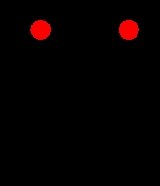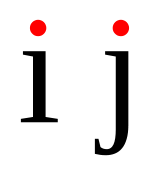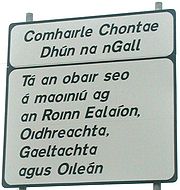
Tittle
Encyclopedia

Diacritic
A diacritic is a glyph added to a letter, or basic glyph. The term derives from the Greek διακριτικός . Diacritic is both an adjective and a noun, whereas diacritical is only an adjective. Some diacritical marks, such as the acute and grave are often called accents...
or the dot on a lowercase i or j. The tittle is an integral part of the glyph
Glyph
A glyph is an element of writing: an individual mark on a written medium that contributes to the meaning of what is written. A glyph is made up of one or more graphemes....
of i and j, but diacritic dot
Dot (diacritic)
When used as a diacritic mark, the term dot is usually reserved for the Interpunct , or to the glyphs 'combining dot above' and 'combining dot below'...
s can appear over other letters in various languages. In most languages, the tittle of i or j is omitted when a diacritic is placed in the tittle's usual position (as í
Í
is a letter in the Faroese, Hungarian, Icelandic, Czech, Slovak, and Tatar languages. This letter also appears in Catalan, Irish, Occitan, Portuguese, Spanish, Galician, Leonese, Navajo, and Vietnamese language as a variant of letter “i”....
or ĵ
J
Ĵ or ĵ is a letter in Esperanto orthography representing the sound .While Esperanto orthography uses a diacritic for its four postalveolar consonants, as do the Latin-based Slavic alphabets, the base letters are Romano-Germanic...
), but not when the diacritic appears elsewhere (as į
I
I is the ninth letter and a vowel in the basic modern Latin alphabet.-History:In Semitic, the letter may have originated in a hieroglyph for an arm that represented a voiced pharyngeal fricative in Egyptian, but was reassigned to by Semites, because their word for "arm" began with that sound...
, ɉ).
History and usage
The tittle first appeared in LatinLatin
Latin is an Italic language originally spoken in Latium and Ancient Rome. It, along with most European languages, is a descendant of the ancient Proto-Indo-European language. Although it is considered a dead language, a number of scholars and members of the Christian clergy speak it fluently, and...
manuscripts in the 11th century, to distinguish the letter i from strokes of nearby letters. Although originally a larger mark, it was reduced to a dot when Roman
Roman type
In typography, roman is one of the three main kinds of historical type, alongside blackletter and italic. Roman type was modelled from a European scribal manuscript style of the 1400s, based on the pairing of inscriptional capitals used in ancient Rome with Carolingian minuscules developed in the...
-style typeface
Typeface
In typography, a typeface is the artistic representation or interpretation of characters; it is the way the type looks. Each type is designed and there are thousands of different typefaces in existence, with new ones being developed constantly....
s were introduced.
The word tittle is rarely used. Its most prominent occurrence is in the introduction to the Antithesis of the Law in the Gospel of Matthew
Gospel of Matthew
The Gospel According to Matthew is one of the four canonical gospels, one of the three synoptic gospels, and the first book of the New Testament. It tells of the life, ministry, death, and resurrection of Jesus of Nazareth...
(5:18): "For verily I say unto you, Till heaven and earth pass, one jot or one tittle shall in no wise pass from the law, till all be fulfilled" (KJV). The quotation uses them as an example of extremely minor details. The phrase "jot and tittle" indicates that every small detail has received attention.
In the Greek
Greek language
Greek is an independent branch of the Indo-European family of languages. Native to the southern Balkans, it has the longest documented history of any Indo-European language, spanning 34 centuries of written records. Its writing system has been the Greek alphabet for the majority of its history;...
original translated as English "jot and tittle" is found iota and keraia
Keraia
Keraia may refer to either of the following diacritic marks:*Keraia *Tittle...
. Iota
Iota
Iota is the ninth letter of the Greek alphabet. In the system of Greek numerals it has a value of 10. It was derived from the Phoenician letter Yodh . Letters that arose from this letter include the Roman I and J and the Cyrillic І , Yi , Je , and iotified letters .Iota represents...
is the smallest letter of the Greek alphabet
Greek alphabet
The Greek alphabet is the script that has been used to write the Greek language since at least 730 BC . The alphabet in its classical and modern form consists of 24 letters ordered in sequence from alpha to omega...
(ι), and was used as a small diacritic below other vowels (the hypogegrammeni) in ancient Greek texts. Alternatively, it may represent yodh
Yodh
Yodh is the tenth letter of many Semitic alphabets, including Phoenician, Aramaic, Hebrew Yud , Syriac and Arabic...
(י), the smallest letter of the Hebrew and Aramaic alphabet
Aramaic alphabet
The Aramaic alphabet is adapted from the Phoenician alphabet and became distinctive from it by the 8th century BC. The letters all represent consonants, some of which are matres lectionis, which also indicate long vowels....
s. "Keraia" is a hook or serif
Serif
In typography, serifs are semi-structural details on the ends of some of the strokes that make up letters and symbols. A typeface with serifs is called a serif typeface . A typeface without serifs is called sans serif or sans-serif, from the French sans, meaning “without”...
, possibly referring to other Greek diacritics, or possibly to the hooks on Hebrew or Aramaic letters, (ב) versus (כ), or additional marks such as crowns (e.g. the Vulgate
Vulgate
The Vulgate is a late 4th-century Latin translation of the Bible. It was largely the work of St. Jerome, who was commissioned by Pope Damasus I in 382 to make a revision of the old Latin translations...
apex) found in the Torah. A keraia is also used in Greek numerals
Greek numerals
Greek numerals are a system of representing numbers using letters of the Greek alphabet. They are also known by the names Ionian numerals, Milesian numerals , Alexandrian numerals, or alphabetic numerals...
.
Dotless and dotted i

A number of alphabets use dotted and dotless I, both upper and lower case.
In the modern Turkish alphabet
Turkish alphabet
The Turkish alphabet is a Latin alphabet used for writing the Turkish language, consisting of 29 letters, seven of which have been modified from their Latin originals for the phonetic requirements of the language. This alphabet represents modern Turkish pronunciation with a high degree of accuracy...
, the absence or presence of a tittle distinguishes two different letters
Turkish dotted and dotless I
The Turkish alphabet, which is a variant of the Latin alphabet, includes two distinct versions of the letter I, one dotted and the other dotless. The difference between the two versions is modelled after the letters Ö and Ü, which were taken from German. These two letters represent front-vowel...
representing two different phonemes: the letter "I" / "ı", with the absence of a tittle also on the lower case letter, represents the close back unrounded vowel
Close back unrounded vowel
The close back unrounded vowel, or high back unrounded vowel, is a type of vowel sound used in some spoken languages. The symbol in the International Phonetic Alphabet that represents this sound is . Typographically a turned letter m, given its relation to the sound represented by the letter u it...
[ɯ], while "İ" / "i", with the inclusion of a tittle even on the capital letter, represents the close front unrounded vowel
Close front unrounded vowel
The close front unrounded vowel, or high front unrounded vowel, is a type of vowel sound, used in many spoken languages. The symbol in the International Phonetic Alphabet that represents this sound is ....
[i].
In the latest Latin-based Kazakh alphabet
Kazakh alphabet
The Kazakh alphabets are the alphabets used to write the Kazakh language. The Kazakh language uses the following alphabets:* The Cyrillic script is officially used in the Republic of Kazakhstan and Bayan-Ölgiy Province in Mongolia...
, there is also a dotted and dotless letter i and I for different sounds.
There is only one letter I in Irish
Irish language
Irish , also known as Irish Gaelic, is a Goidelic language of the Indo-European language family, originating in Ireland and historically spoken by the Irish people. Irish is now spoken as a first language by a minority of Irish people, as well as being a second language of a larger proportion of...
, but i is undotted in the traditional uncial
Uncial
Uncial is a majuscule script commonly used from the 3rd to 8th centuries AD by Latin and Greek scribes. Uncial letters are written in either Greek, Latin, or Gothic.-Development:...
Gaelic script
Gaelic script
Gaelic type, sometimes called Irish character, Irish type, or Gaelic script, is a family of insular typefaces devised for printing Irish and used between the 16th and 20th centuries. Sometimes all Gaelic typefaces are called Celtic or uncial, though most Gaelic types are not uncials...
to avoid confusion of the tittle with the buailte overdot found over consonant
Consonant
In articulatory phonetics, a consonant is a speech sound that is articulated with complete or partial closure of the vocal tract. Examples are , pronounced with the lips; , pronounced with the front of the tongue; , pronounced with the back of the tongue; , pronounced in the throat; and ,...
s. Modern texts replace the buailte with an h, and use the same antiqua-descendant fonts, which have a tittle, as other Latin-alphabet languages. However, bilingual road signs use dotless i in lowercase Irish text to better distinguish i from í
Í
is a letter in the Faroese, Hungarian, Icelandic, Czech, Slovak, and Tatar languages. This letter also appears in Catalan, Irish, Occitan, Portuguese, Spanish, Galician, Leonese, Navajo, and Vietnamese language as a variant of letter “i”....
. The letter "j" is not used in Irish other than in foreign words.
In most Latin-based orthographies, the lowercase letter i loses its dot when a diacritical mark, such as an acute
Acute accent
The acute accent is a diacritic used in many modern written languages with alphabets based on the Latin, Cyrillic, and Greek scripts.-Apex:An early precursor of the acute accent was the apex, used in Latin inscriptions to mark long vowels.-Greek:...
or grave accent
Grave accent
The grave accent is a diacritical mark used in written Breton, Catalan, Corsican, Dutch, French, Greek , Italian, Mohawk, Norwegian, Occitan, Portuguese, Scottish Gaelic, Vietnamese, Welsh, Romansh, and other languages.-Greek:The grave accent was first used in the polytonic orthography of Ancient...
, is placed atop the letter. However, in Vietnamese
Vietnamese language
Vietnamese is the national and official language of Vietnam. It is the mother tongue of 86% of Vietnam's population, and of about three million overseas Vietnamese. It is also spoken as a second language by many ethnic minorities of Vietnam...
and sometimes in the Baltic languages
Baltic languages
The Baltic languages are a group of related languages belonging to the Balto-Slavic branch of the Indo-European language family and spoken mainly in areas extending east and southeast of the Baltic Sea in Northern Europe...
, the lowercase letter i traditionally retains its dot even when accented. This detail is often lost in computers and on the Internet, due to the obscurity of language-specific fonts.
Phrases
- It is thought that the phrase "to a T" is derived from this word.
- The phrase "to dot one's is and cross one's ts" is used literally and also to mean "to put the finishing touches to" or "to be thorough".

